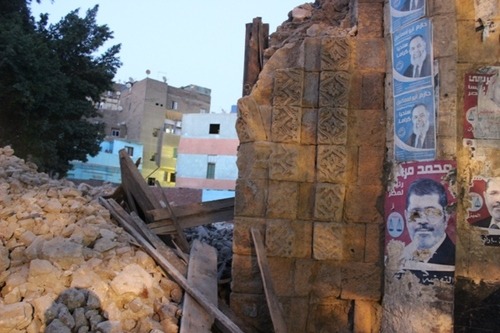Destruction Alert: historic gate demolished with official approval

This week a gate that belonged to a large residential complex, which was already demolished, was bulldozed with the permission of authorities. The demolition has caused outrage and protest by concerned citizens. The gate appears to date from sometime between the mid-18th century to the early 19th century and was located on Bab al Wazir Street in the heart of historic Cairo’s Darb el Ahmar district. The building was once the home of Egypt’s grand Mufti (1921-1928). The demolition comes at a time when the heart of historic Cairo has been continuously under assault losing entire historic houses (typically three stories) which have been replaced by taller, higher density modern apartment blocks as tall as 8-10 stories. Domestic architecture, no matter how old, is rarely registered as monument, which means that the primary elements of historic districts such as Darb el Ahmar are extremely vulnerable in the face of real estate speculation, typically within the informal economy sector which involves paying large sums by the developers to the authorities in order to turn a blind eye to their building frenzy.
Mohamed Abdelaziz, the official responsible for the development of historic Cairo project at the antiquities ministry, deflected the news by arguing that the gate was of no historic significance and that the demolition was completely legal. This incident raises several persistent questions which have not been confronted regarding Cairo’s urban development particularly in historic areas.

[The destroyed gate which was already vandalized by election posters for Islamist candidates including the current president. Photo by Ahmed Hamed via Aswatmasriya.com]
The most pressing question is WHO in Egypt today determines what counts as heritage/patrimony and who decides on the categories? There are multiple governmental bodies responsible for different and often overlapping kinds of heritage often governed by outdated rigid categories which often have orientalist or colonial origin. For example, the vast and vague category of “Islamic Architecture”: What is and what is not “Islamic” architecture? This gate was determined undeserving of protection because it was not “registered as an Islamic monument.” In fact the decorative motifs seen in this gate can be found in many residential structures from that period and they often go undocumented and dismissed because they do not easily fit into 19th century categories of Mamluk, Ottoman, Fatimid, etc. There are house gates with floral motifs, others with faces carved above the portal and others with letters or family symbols. Such diversity and architectural individuality do not interest the official institution of antiquities (governed by dated art historical categories imposed from elsewhere), because these houses are/were part of the everyday and often belonged to families with no notable members. Spaces of the everyday, even if centuries old and well-built and expressing innovative building craft, are not part of the record.
But even buildings which were listed have not benefited from their listing and are often neglected, undeveloped, and un-restored. With few exceptions such as the Aga Khan project for Darb el Ahmar, there has been no comprehensive urban development plan for historic areas that take economy into account. Listed buildings, under current laws, are economic burdens on their owners who are highly restricted from benefiting financially from their valuable property by perhaps acquiring permits for renovations or adapting them to new uses. Thus, even listed buildings are often intentionally damaged by their owners in order to qualify for a demolition permit and often architects and engineers working for the state bureaucracy assist owners in destroying their own properties for a fee, knowing that once the property is freed of its heritage building it can be developed with profitable real estate. It is shameful that over a decade into the twenty-first century a country like Egypt and a city like Cairo, which had and continues to have a high density of historic structures waiting to be adapted and incorporated into an urban economy, there is yet to emerge a sufficient system to deal with this heritage properly. Lack of imagination and corruption in peacetime are causing damage to Cairo’s urban heritage at a rate that could only be matched by a natural disaster or war. Indeed images of damaged listed buildings such as Villa Casdagli (oddly registered as an Islamic Monument), resemble war damage. State institutions responsible for that listed building have not moved to respond to that damage not least to erect a fence around the property five months after its destruction.
It is important to note that major buildings which were listed were demolished with official permission in recent months. Last month Cinema Rialto, one of Alexandria’s landmark cinemas disappeared over night.
Thus, listing is not the primary issue regarding the demolition of the Darb el Ahmar gate, since listed buildings face a similarly uncertain fate.

[The emerging skyline of the once historic Darb el Ahmar district as seen from Azhar Park]
The other issue presented by this latest catastrophe is the persistent question of adaptive reuse: Why were the wall and gate not incorporated into a new structure? such practices have a long history in Cairo as ancient as the city itself. Buildings and parts of buildings have been continuously incorporated into new structures for centuries. Across historic Cairo an observant eye will pick out fragments of ancient buildings incorporated into subsequent structures creating a sense of layering and richness which makes the historic city so exciting. However, for such practices to take place today two elements are fundamental: (1) an overall vision and policy that encourages the adaptive reuse of buildings or architectural fragments, and (2) the necessary technique and design practice needed to consult the construction of new buildings containing existing fragments. What is needed is a serious exploration of the possibilities that lie between total annihilation approach and the “open air museum” approach to historic urban areas.
The demolitions of this gate and of many other historic structures across the country are often “legal.” Legality here merely connotes that developers acquired the needed permissions in exchange for a hefty “gift” to local officials, municipal engineers and police officers.
Finally, to conclude, the unnecessary demolition of this gate is an occasion to shame some of the incompetent institutions responsible for Cairo’s urban environment: Shame on the so-called National Organization for Urban Harmony. Shame on the Governorate of Cairo. Shame on the Ministry of Antiquities. Shame on the Ministry of Culture. Shame on the Awqaf Ministry. Shame on the Ministry of Housing. All the above institutions have a track record of failure and mediocrity dominated by corruption and cronyism. All these bureaucracies have together failed to emerge with a vision for the protection and development of Egypt’s historic urban centers in ways that save heritage, allow for social continuity (no evictions) and economic prosperity.
3 notes
oumcartoon liked this
evelyngorfram-blog1 liked this
arch-sally reblogged this from cairobserver
cairobserver posted this

